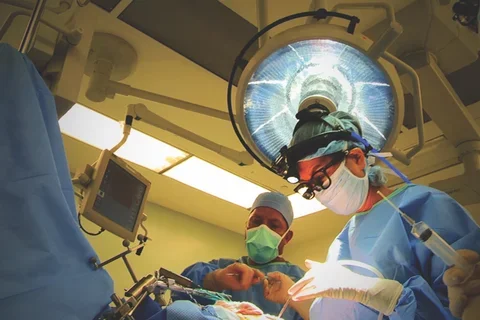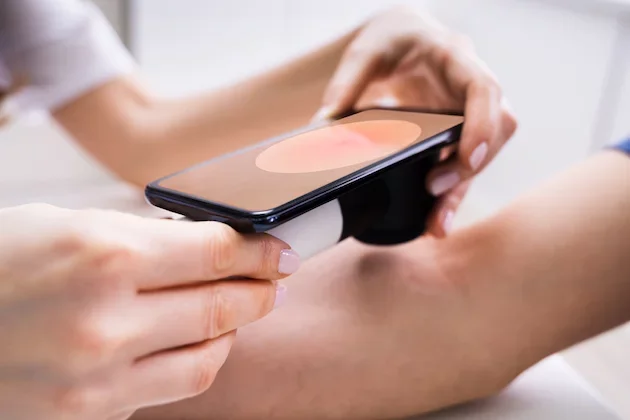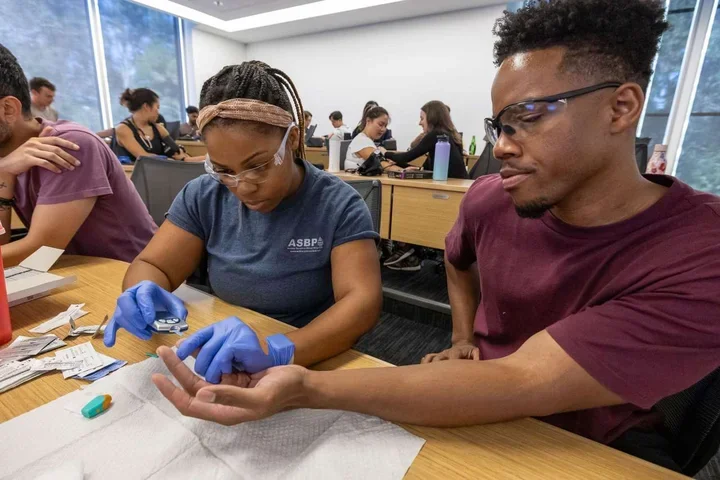What Is Mohs Surgery?
Research Spotlight

Mohs Micrographic Surgery
Mohs micrographic surgery is a precise technique for removing some common skin cancers from delicate and/or highly visible areas, such as the head, neck, nostrils, ears, mouth, and all other parts of the face, as well as the hands and feet.
Preserving the functionality and aesthetics of delicate areas requires Mohs surgeons to remove cancer with greater precision than a standard cancer excision.
Surgeons generally aim for wide margins when removing cancers. By taking this approach, they hope to remove not only the visible tumor but also as many cancerous cells in the surrounding tissue as possible. If they leave many cancerous cells behind, recurrence rate increases.
Mohs micrographic surgery is the most effective way to remove cancer while preserving as much healthy tissue as possible.
Named after its originator, the late Frederic E. Mohs, MD, the procedure relies on a methodical process to remove cancer with equal thoroughness but greater precision for complete removal.
Meet Dr. Jenny Kim, Dermatologist at UCLA Health
UCLA dermatologist Jenny Kim, MD, PhD joined the David Geffen School of Medicine at UCLA (DGSOM) faculty in 2000, but she’s been part of the UCLA community since her medical school days.

After earning her medical degree at DGSOM, she stayed at UCLA to complete her dermatology residency, get a PhD in immunology, and do her Mohs micrographic surgery, lasers, and cosmetic dermatology fellowship.
She now teaches dermatology and serves as Director of Cosmetic Dermatology and the Micrographic Surgery and Cutaneous Oncology Fellowship in the Division of Dermatology. UCLA has recognized her with a Dean’s award and in celebrations of trailblazers and women of achievement, and the Los Angeles Business Journal has named her one of the city’s top doctors and leaders of influence.
She also conducts research. Her lab investigates the skin’s immune functions and how those functions impact the development and progression of dermatologic diseases.
It may surprise many people to learn that Dr. Kim’s successful career in dermatology grew out of an interest in immunology. She recalls her curiosity developing while reading a special issue of a magazine created for lay people.
“It talked about how we need to fight infection with our immune response and even some inflammation, but also that same inflammation, when too much, can cause disease,” she says. “I found it endlessly fascinating—that balance the immune system requires.”
Personal experiences deepened her interest in immunology. She lost her father to liver failure before he could be matched with a compatible organ for transplant, one his immune system wouldn’t attack. The loss motivated her to learn more about the immunological underpinnings of transplant rejection and acceptance.
Dr. Kim’s earliest professional medical experience came from working in the lab of the late Paul I. Terasaki, PhD, a trailblazer in understanding transplant immunology and advancing transplant medicine.
“It was a remarkable experience,” she recalls. “To be—at such a young age—exposed to someone like Dr. Terasaki, who had made such a contribution to science and also to UCLA.”
Becoming a Mohs Micrographic Surgeon
As a DGSOM student, Dr. Kim explored other interests, but she found herself approaching everything she learned through an immunology-focused lens.
Working in the lab of UCLA’s Robert L. Modlin, MD, a dermatologist interested in the skin’s immune response, helped Dr. Kim more clearly see how immunology might shape her future career.
“It was something I’d never thought about before—combining immunology and dermatology.”
She found a path for incorporating both dermatology and immunology into her career plans through the Specialty Training and Advanced Research (STAR) program at DGSOM. The program enables aspiring physician-scientists to pursue research training concurrent with their clinical residencies and/or fellowships.
Dr. Kim was among the earliest participants in the now well-established STAR program. She earned a PhD in immunology in addition to completing her residency training in dermatology and her fellowship training in Mohs micrographic surgery.
Mohs Micrographic Surgery Procedure
A surgeon using the Mohs technique identifies the primary skin cancer tumor and then removes it along with a conservative layer of surrounding tissue.
Dr. Kim says each layer they remove is usually very thin and is processed to pathology in layers thin as a piece of paper.
The surgeon then examines the processed and stained tissue using a microscope on site.
“We use a microscope to read the pathology of that tissue. We check all the peripheral margins as well as the depth of the lesion,” Dr. Kim explains
This real-time analysis is a key characteristic of Mohs surgery. Standard surgical procedures typically involve a waiting period, when removed tissue travels to a pathology lab for testing and analysis. The surgeon must wait to receive the results before determining if their patient needs additional surgery or other interventions. With Mohs surgery, the area with remaining cancer cells can be identified immediately. Then the surgeon can go back to remove any cancer remaining in the patient.
Mohs surgeons may repeat this process, removing conservative segments of tissue and checking on their progress under a microscope until they they’ve removed all of the tumor and surrounding cancerous cells.
“It's a very efficient and precise way to take out all the skin cancer,” Dr. Kim explains. “Seeing the skin cancer cells in real time and working gradually allows us to remove cancer and preserve as much normal tissue as possible.”

Types of Skin Cancer
Many different cancers can develop in the skin. They’re classified according to the type of cells they originate from. The most common skin cancers include:
- Basal cell carcinoma (BCC): A skin cancer that originates in the basal cells found in the base of the epidermis.
- Squamous cell carcinoma (SCC): A skin cancer that originates in the squamous cells found in the middle epidermis.
- Melanoma: A skin cancer that originates in melanocytes, the cells that make up a pigment in skin called melanin.
“The most common skin cancers are basal cell carcinomas and squamous cell carcinomas,” says Dr. Kim.
Basal cell skin cancers are the most common of all skin cancers. BCCs account for about 8 out of 10 skin cancer cases. Melanoma is less common in terms of occurrence. However, it may be the type people are most familiar with as it can be serious if not detected and treated early.
“What's important for all these cancers is early detection and treatment,” Dr. Kim says.
Individuals can benefit from sun protection and healthy skin habits, getting a full skin check with a board-certified dermatologist yearly, and doing regular self skin checks at home. They should see a dermatologist if they notice any of these common skin-cancer symptoms:
- Developing or changing areas of the skin, such as…
- Lesions
- Itchy patches
- Sores
- Tenderness and/or sensitivity
- Bleeding, especially from moles
- Changes in moles, including fluctuations in their…
- Size
- Color
- Shape
- Outline
- Texture
Is Skin Cancer Deadly?
Skin cancer can be deadly.
All skin cancers have the ability to spread from a localized area to other parts of the body and become very serious if not treated. Of all the skin cancer types, melanoma is the most aggressive. Therefore, it’s often considered the most deadly skin cancer.
According to the American Cancer Society, only about 1% of all skin cancer cases are melanomas. But that 1% causes a majority of skin-cancer deaths.
When detected and treated early, most skin cancers, including melanomas, can be cured.
“Immune therapy has made a huge difference for patients with advanced melanomas,” Dr. Kim says.
She remembers a time not so long ago, when prognoses for rapidly spreading cancers like melanoma were not so favorable.
Despite therapeutic innovations, early detection and treatment is what determines whether or not any given melanoma case will become deadly. According to the American Academy of Dermatology Association, melanoma cases caught and treated before the cancer spreads to the lymph nodes are associated with a 99% 5-year survival rate.
Skin Cancer Treatment
Skin cancer is a highly treatable type of cancer when it’s detected and managed early in its development and progression.
There are also many different approaches to skin cancer treatment.
Dermatologists will determine the best treatments based on their patient’s skin cancer type, stage, and location on the body, among other relevant case-by-case factors.
Skin cancer treatment options include:
- Removal via excisional surgery
- Removal via Mohs surgery
- Radiation therapy
- Chemotherapy
- Immunotherapy
- Photodynamic therapy
- Other targeted and/or drug-based therapies
Mohs Surgery for Melanoma
Mohs surgery can treat melanoma but may not always be the best treatment option for all melanomas. Recently Mohs surgery with immunohistochemistry staining is being performed for the treatment of some melanomas. However, if a patient’s melanoma has spread deep into the tissue, for example, alternative therapies may be more conducive to achieving the best outcomes.
"We have a multidisciplinary approach to manage advanced melanoma with our colleagues in surgical oncology and oncologists," says Dr. Kim.
A patient’s dermatologist will determine if Mohs surgery is the right choice for their situation. In general, they recommend Mohs surgery for treating basal cell carcinomas (BCC) or squamous cell carcinomas (SCC) that are in delicate and/or visible areas, such as the head and neck, or that have shown aggressive growth.
“We don’t use Mohs as much for melanomas and other rare skin cancers,” says Dr. Kim.
New approaches in development, such as using immune markers on certain tumors, could enable Mohs surgeons to better interpret melanomas and other difficult to read skin cancers in real time.
Currently, Mohs surgeries for removing melanomas may take longer than surgeries to remove basal or squamous cell carcinomas. Sometimes, it can be more difficult for surgeons to detect melanoma cells under their microscope. They may need to send samples out to pathology labs for additional testing and analysis before proceeding.
Skin Cancer Prevention & Awareness Month
It’s no accident that May, the month many people begin having and planning their summer fun, is also Skin Cancer Prevention & Awareness Month.
The observance reminds everyone—at a time when sun protection is top of mind—-about practical steps they can take to protect their skin and help prevent skin cancer throughout the entire year.
How to Prevent Skin Cancer
The following habits can help individuals prevent sun damage and reduce their risk of developing skin cancer.
Doing regular self checks to monitor moles, lesions, and other changes on their skin.
Remember ABCDE when checking moles:
- A (Asymmetry) Check for changes in symmetry
- B (Border) Check for changes in shape
- C (Color) Check for changes in color
- D (Diameter) Check for changes in size
- E (Evolution) Check for new growth
Getting routine preventative skin checks from a board-certified dermatologist.
Discussing their family history and other individual skin-cancer risk factors with a dermatologist. A dermatologist can help clarify individual risk and determine, if necessary, a personalized plan for protecting and monitoring the skin.
Factors that increase an individual's risk of developing skin cancer include:
- Family history of skin cancers
- Personal history of excessive exposure to sun and/or sun lamps
- Personal history of frequent and/or severe sunburns
- Compromised immune system
- Having fair skin
Avoiding sun exposure during peak hours (10 AM to 4 PM).
Protecting themselves when they do get sun exposure by…
- Using sunscreen with an SPF (sun protection factor) of 30+ that provides broad-spectrum protection from UVA / UVB rays as well as physical block. (Physical sunscreen coats skin with a barrier that reflects harmful rays as opposed to chemical sunscreens that absorb the rays.)
- Reapplying sunscreen every 2 hours, or more often if they’re sweating, swimming, or engaging in water sports.
- Remaining under shade or in shady areas as much as possible.
Read more summer sun safety tips from a UCLA dermatologist and skin cancer expert.
Common Misconceptions About Skin Cancer
Increasing public awareness of skin cancer and evidence-based prevention strategies involves clarifying misconceptions that may hinder the adoption of healthier habits. In the spirit of Skin Cancer Prevention & Awareness Month, Dr. Kim clarified a few common misconceptions she hears about skin cancer.
Misconception: Only people with fair skin develop skin cancer.
Skin cancer can develop in skin of all shades and pigments. Dr. Kim says it’s crucial for everyone to check their skin thoroughly.
Learn how UCLA is working to make dermatology care equitable across all skin colors.
Misconception: Sun protection is necessary only when it’s sunny.
The rays in sunlight that cause sunburns—and can lead to the development of skin cancer—are always present, even on overcast days.
Misconception: Skin cancer is not a serious problem.
Skin cancer is a serious problem. All types can metastasize and become threatening if not treated.
Neglecting to take skin cancer seriously will only allow it to become even more serious.
“Once you have skin cancer, you have a higher chance of developing another one,” Dr. Kim says, adding that treating recurring cases can be problematic. “It can be disfiguring, if you need to have multiple Mohs surgeries to remove skin cancers from your face.”
Skin Cancer Prevention & Awareness Month: Dr. Kim’s Take-Home Message
Dr. Kim urges everyone to recognize the importance of skin-cancer prevention and healthy skin habits.
Most people can reduce their skin-cancer risk by making simple lifestyle changes.
“Just get in the habit of taking care of your skin health every day,” she says.
People can focus on limiting sun exposure—not completely avoiding it. Limiting requires small and simple changes, such as enjoying outdoor workouts before or after peak sun exposure hours and always putting on sunscreen, protective clothing, and a hat when heading outside.
Making small changes to help prevent skin cancer from developing, she says, is much easier and better for long-term outcomes than waiting for cancer to develop before taking action.



